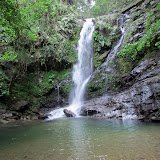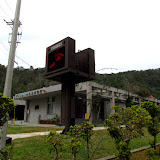 |
| A Nameless Waterfall (Fukugawa II) |
View Map It! Okinawa in a larger map
 |
| River Trekking to a Nameless Waterfall (Fukugawa II) |
GPS
| Latitude | Longitude |
| N 26 36.158 | E 128 03.376 |
River Trekking to a Nameless Waterfall (Fukugawa II)
Seeing one waterfall is great. Seeing another one up the stream makes it all the more enjoyable. At the moment, it is not known if the waterfall you see above has an official name. It sits along the same river stream that feeds its baby sister, Fukugawa Taki, roughly separated by a 45 minute hike along the stream. Hence, the momentary name we have given it is Fukugawa II. Your journey starts from the top of Fukugawa I. See article on "Fukugawa Falls" to learn how to get to Fukugawa.
The journey to Fukugawa II is what makes it exciting. Just like the Taa Falls in Ogimi, you have to trek along the river to see it. However, Fukugawa II is not as easy to get to. You have to negotiate over more rock terrain to get further up stream. Rarely will you see any flat, soft areas to walk on. Because of its difficulty, it is highly recommended that only young adults and above go on this venture. But use your best judgment.
Despite, the laundry list of safety precautions below, you can have a safe and fun time. But you do have to be prepared. Again, approach this with a sense of humility and respect towards mother nature. Below are some tips to keep you safe.
Despite, the laundry list of safety precautions below, you can have a safe and fun time. But you do have to be prepared. Again, approach this with a sense of humility and respect towards mother nature. Below are some tips to keep you safe.
GUIDELINES (PLEASE READ).
1. VERY IMPORTANT. Plan on getting wet up to your knees. The reason this is soo important is that it is sometimes safer just to walk in the river, rather than hopping and balancing yourself on the boulders & rocks just to keep dry. If the boulders are wet (& best to assume they will be), they will be slippery. Though this rule may seem trivial, it is the most important thing to remember. The biggest risk trekking along this stream is slipping and falling on the rocks. That is why this is Rule #1.
2. DO NOT WEAR TENNIS SHOES!!! Tennis shoes offer no traction and will slip on these rocks. Wear something that has hard soles and has great traction on these kinds of surfaces. If you do not have hard soles you will 'feel' every step you take. And since you will be getting wet, thick heavy boots will only get heavier when soaked. You should wear something that is lighter, has good traction, but still gives you flexibility of movement.
2. DO NOT WEAR TENNIS SHOES!!! Tennis shoes offer no traction and will slip on these rocks. Wear something that has hard soles and has great traction on these kinds of surfaces. If you do not have hard soles you will 'feel' every step you take. And since you will be getting wet, thick heavy boots will only get heavier when soaked. You should wear something that is lighter, has good traction, but still gives you flexibility of movement.
3. Never go alone. Have a buddy. For this particular river trek, the 'ideal' number is to have at least three (3) hiking buddies if you can. If one gets hurt, then you have the option of leaving one with the injured while the other go gets some help. Cell phone reception is very difficult, if not non-existent in these areas.
4. Tell someone where you will be river trekking at and leave them the GPS coordinate of the starting point. Not everybody, to include Okinawans, will know of this particular waterfall. GPS to the starting point to both Fukugawa I and II is N26 36.488, E128 3.228.
5. Wear something that is long sleeve and light (depending on the weather) for protection against the elements and bugs.
6. Wear a hat or beanie to keep warm and to protect yourself against the elements and bugs. You will run into many spider webs along the way (Do a 'spider check' with your buddy every now and then). A beanie does offer some bit of protection as a cushion in the event of a fall.
7. Bring some light hiking gloves for grip and protection. You may be required to grab roots, tree limbs, trees, rocks, dirt, etc. in order to negotiate terrain.
8. Highly recommend not wearing shorts. Find something that you don't mind getting wet in and that offers protection against the elements. There 'will' be a few times you will be on your knees or on your rear end as you negotiate some of the terrain.
9. Apply the '3-Points of Contact Rule' when going over difficult terrain.
10. Maintain a low center of gravity when going over difficult terrain.
11. If something looks unsafe, then don't do it. Find another way to go around it or SIMPLY, DON'T DO IT. Don't try to be brave. Mother Nature will have the last say.
12. Give yourself plenty of time AND TAKE YOUR TIME. NO NEED TO RUSH. But remember you have add time to get back (before dark!). Recommend you leave early morning time frame.
13. Bring a light backpack for food, water, toilet paper, flash light, survival kit, first aid kit, light rain coat, warming layers, etc.
14. USE THE BATHROOM BEFORE YOU GO! Making natural deposits of certain kind in the wild may not be fun for some.
15. You will get dirty. Bring a towel, extra socks, extra pair of shoes, shirt, pants, warming layers (Can leave in the car).
16. Guide Stick. Having a guide stick may end up being more of a hazard than a safety plus. You need your hands to be free to feel and grab. Just be alert when walking through vegetation and take it slow.
17. Skirting the Terrain Vs Walking in the Water. Skirting the terrain can be more of an impediment and little more dangerous. Again, assume on getting wet in order to negotiate terrain safely. Safety should be the considering factor on whatever you should try to do.
18. Tuck in your shoe laces to prevent tripping.
19. Protect & secure items such as your wallet and cell phone from moisture and from getting soaked.
20. Don't try to be brave. Respect your limits and respect nature.
Beyond Fukugawa II. When you arrive to Fukugawa II, the question then becomes: is there anything worth seeing on top and beyond? The answer is: not really. Pictures have been provided in the photo album. The view from down below is impressive enough. Getting over Fukugawa II is a little more physical demanding and little more dangerous cause of the steepness. On top, there is a man-made bridge-like structure that holds irrigation pipes that feed out water (possibly out to a farm). For safety, try to avoid these man-made pipe bridges. There are small paths off to the side of these bridges (though narrow) that may offer passage assistance to the top. Use your best judgment. Safety First. Again, the view from down below is impressive enough.
Beyond Fukugawa II. When you arrive to Fukugawa II, the question then becomes: is there anything worth seeing on top and beyond? The answer is: not really. Pictures have been provided in the photo album. The view from down below is impressive enough. Getting over Fukugawa II is a little more physical demanding and little more dangerous cause of the steepness. On top, there is a man-made bridge-like structure that holds irrigation pipes that feed out water (possibly out to a farm). For safety, try to avoid these man-made pipe bridges. There are small paths off to the side of these bridges (though narrow) that may offer passage assistance to the top. Use your best judgment. Safety First. Again, the view from down below is impressive enough.
Further down the stream is another man-made structure that appeared be a control valve station at one time. The river flattens out and narrows with several 'Y' forks streams along the way. Our turn-around point was at GPS coordinate N26 38.594 E128 51.834 (an estimated 1.5 kilometer distance from Fukugawa II). By the Google map, our turn-around point was roughly 300meters from the nearest road.
Destination Time. The time between Fukugawa I and II is roughly 45 minutes when going at a reasonable safe pace.
Other Waterfalls of Okinawa (沖 縄 滝). Azaka Falls (Ogimi Village), Fukugawa Falls (Nago City), Hira Falls, Meoto Falls (Higashi Village), Ogimi Waterfall (Ogimi Village), Taa Waterfall (Ogimi Village), Todoroki Waterfall (Nago City), Kijoka Falls, Nameless Waterfall (Kunigami).









